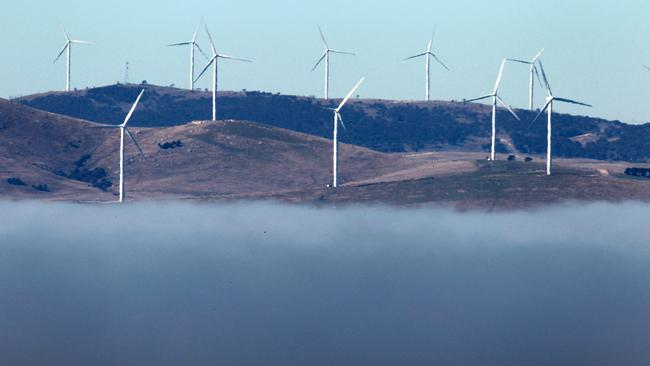Canberra’s clean energy strategy hits hip pockets
While ACT households have paid a premium for clean energy under the territory’s 100 per cent renewables target, customers are now being shielded from higher wholesale prices.

Householders and businesses in the nation’s capital have been paying a premium for clean energy – suffering a “first mover’s disadvantage” – after the ACT locked in long-term contract prices for electricity generated by large-scale renewable projects.
But the unique ACT energy system has also been designed to shield customers from higher wholesale prices, meaning that Canberrans have not been hit with the same recent increases in power bills as those in some other states.
The ACT has claimed to be 100 per cent powered by renewables since 2020, with the Territory arguing it is leading the nation on climate change despite relying on NSW coal-fired power stations to keep the lights on.
The Labor/Greens government in Canberra has introduced a net-zero emissions target by 2045 – the most ambitious in the country – as well as a ban on new gas connections for homes and businesses, a phasing out of new petrol-driven cars by 2035, and a prohibition on wood heaters and fireplaces a decade later.
The Barr government announced in September 2019 that it was the first major jurisdiction outside Europe to make the transition to 100 per cent renewables, and there were only seven other jurisdictions with populations over 100,000 that had achieved the same feat across the globe.
While it remains connected to the NSW grid, the ACT government opted to fund a series of large-scale renewable projects across the country.
These sites in Victoria, NSW and South Australia – when combined with the ACT’s own solar projects – generate the equivalent of the ACT’s annual power usage, with Energy Minister Shane Rattenbury saying it was “an equivalence thing”.
“People will pick this bone and say ‘you cannot guarantee that every electron coming out of a power point is a green electron’. That is true,” he told The Australian, adding: “We still sit in the national grid.”
Under the ACT system, large-scale wind and solar generators are paid for their energy under long-term contracts entered into with the ACT government, and Evoenergy – the electricity distributor in the capital – is charged with administering the scheme. The energy produced by these renewables projects is purchased and offset through a “contract for difference” arrangement.
Senior research associate and energy expert at the University of NSW, Dylan McConnell, explained this approach had resulted in the ACT locking in a long-term price of about $90 per megawatt-hour for electricity from the renewable projects.
Under the “contracts for difference” arrangement, the renewable generators make payments to Evoenergy if the wholesale price lifts above that specified in the contract. But Evoenergy must make payments to the generators if wholesale prices fall below the price set out in the contract.
Dr McConnell said the ACT scheme was “designed to counteract wholesale price fluctuations”, and argued it was an effective system because it de-risked investment. “The volatility of the wholesale price does present a pretty significant risk to new developers,” Dr McConnell said.
But he also acknowledged the ACT had a “first mover’s disadvantage” because the government was paying a “bit of a premium on what people today might be paying for a new wind farm or a solar farm”.
“The ACT-supported projects receive an average price of $90/MWh, reflecting the higher costs of renewable energy at the time of their construction compared to today’s prices,” he said.
Analysis conducted by Dr McConnell has shown that, since the first three months of 2019, the ACT has mostly needed to top up the renewable generators, with payments to them peaking at about $30m in the second quarter of 2021-22.
A rise in wholesale prices briefly reversed this trend over 2022, with ACT energy users receiving a reduction on their power bills to the tune of about $60m by June of that year – although this would have been offset by the impact of higher prices.
Grattan Institute energy expert Tony Wood said the territory had made a wise decision when it embarked on its “reverse auction” process to purchase renewable power.
“For a few years the price of electricity in the wholesale market actually went down quite a bit and the result was that the government had to pay to top-up the generators that difference,” he said.
But Mr Wood said the wholesale price of electricity had since “gone up quite significantly” “ACT consumers have been protected from that by this deal because the generators are getting the high price itself, the government gets that back … consumers in the ACT effectively get a rebate.”
Manager of policy and research for the St Vincent de Paul Society, Gavin Dufty, said the ACT was unique because, when wholesale prices were high, “territorians are way in front”.
An analysis of tariff tracking reports produced by the St Vincent de Paul Society showed that, in Canberra, for all-electric households with a typical consumption level of 8000kWh, the annual regulated bill for 2022-23 ranged from $2445 to $2695 depending on the tariff type.
When combining ActewAGL’s regulated electricity rate and gas standing offer, the total cost of energy for average consumption households increased by 9 per cent, or $380.
On average, in the ACT over 2022-23, an electricity market offer bill – inclusive of discounts – was $2290 for households using 8000kWh per annum. That is a rise of $115, or 5 per cent.
By contrast, for NSW in 2022-23, the St Vincent de Paul Society found the average electricity market offer produced an annual bill of $3285 in the Essential Energy network, $2730 in Ausgrid and $2805 in Endeavour.
In Queensland, the average annual bill for households using 8000kWh per annum was about $2820 for market offer customers.


